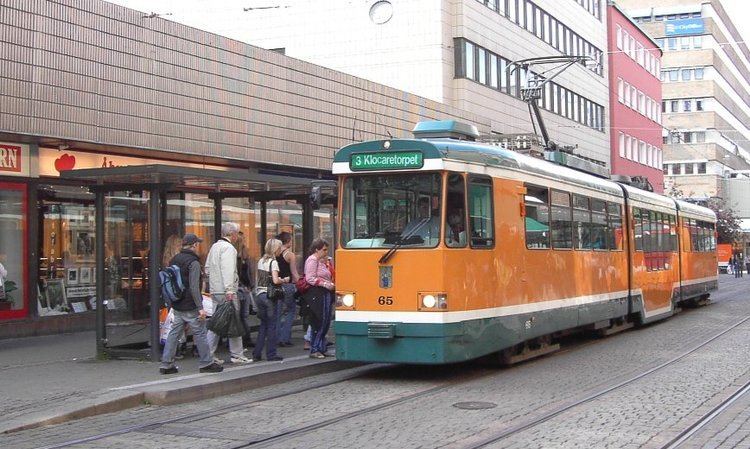Began operation 1904 | Number of stations 50 | |
 | ||
Number of lines 2 (+1 seasonal heritage tram line) | ||
The Norrköping tramway network is a system of trams forming a principal part of the public transport services in Norrköping, Sweden. It has been in service since 1904, and is, along with the larger Gothenburg tram network, one of only two city-centre tramways in Sweden that survived the switch to right-hand traffic in 1967, which led to the replacement of most Swedish tramways with buses to reduce the cost of replacing their now-unusable fleets.
Contents
Routes
Since 1966, there are two routes in the system. Line 2 runs from Fridvalla in the north to Ringdansen in the south along Östra Promenaden in the city centre. Line 3 runs between Vidablick in the north and Klockaretorpet in the south-west via Drottninggatan in the city centre. Both lines stop at the Norrköping Central Station (Resecentrum) where they provide interchange with the national railway network. Interchange with intracity, intercity and suburban bus routes are provided at mainly Resecentrum and Söder tull.
Until 1958, a separate Line 1 trafficked the city centre as a loop, using the stretch of tracks in Kungsgatan (that was since removed in 1961). There is a modern heritage tram Line 1, trafficked with heritage trams from the tram museum in Norrköping, but it operates only seasonally (i.e. summers-only).
As of 2011, Line 2 has been extended to Ringdansen. Until 2006, the Line ended in Klingsberg. In the early 21st century, work began to extend the Line to Ringdansen, some 3 kilometres (1.9 mi) south of Klingsberg. The first part of the extension, to Ljura, opened in 2006 – this stage was only some 350 meters long. This section leaves the Klingsberg track at the Albrektsvägen stop, which means that Klingsberg lost its tram service. Work on the second stage started in 2009, and on October 21, 2010 some 2 kilometres (1.2 mi) of new tramway opened, from Ljura to Trumpetaregatan in Hageby. The third section, from Trumpetaregatan to Ringdansen, was inaugurated exactly one year later, October 21, 2011.
Operations
The Norrköping tramway is a standard-gauge electrically powered system, operated by Transdev on behalf of the regional transport authority, ÖstgötaTrafiken. The infrastructure and the tramcars are, however, property of Norrköping Municipality. It has track loops at the end of the lines and at various other points to allow turnbacks, as most of the trams are unidirectional. The tram depot is located off Östra Promenaden, between the Djäkneparksskolan and Centralbadet stops.
Norrköping’s fleet includes ten Düwag M97 trams, and four ADtranz low-floor trams (designated M98), built originally for Bremen (1) and Munich (3). The original Bremen tram (prototype of the world´s first modern low floor tram) was returned to the transport provider of the city of Bremen BSAG on the 12th of June, 2011 for conservation as a historic tram.
The most recent addition, introduced in 2007, is the Bombardier Flexity Classic (designated M06), a modern low-floor, bidirectional tram used in a number of cities around the world.
In 2011 6 Tatra T6Am acquired secondhand from Berlin were introduced to easy burden on the existing fleet as some new M06 built for Norrköpping were disabled by a flood at the Bombardier facility in Bautzen (Germany). As of 2012 all 6 trams are parked due to missing authorization and/or technical problems.
Ten M67K trams (originally built in 1967 and since modernised) were taken out of regular use in 2008, but remain available as a reserve fleet. The M67K are now constantly in traffic because of that Östgötatrafiken lent all except two of the M06 to Stockholm.
